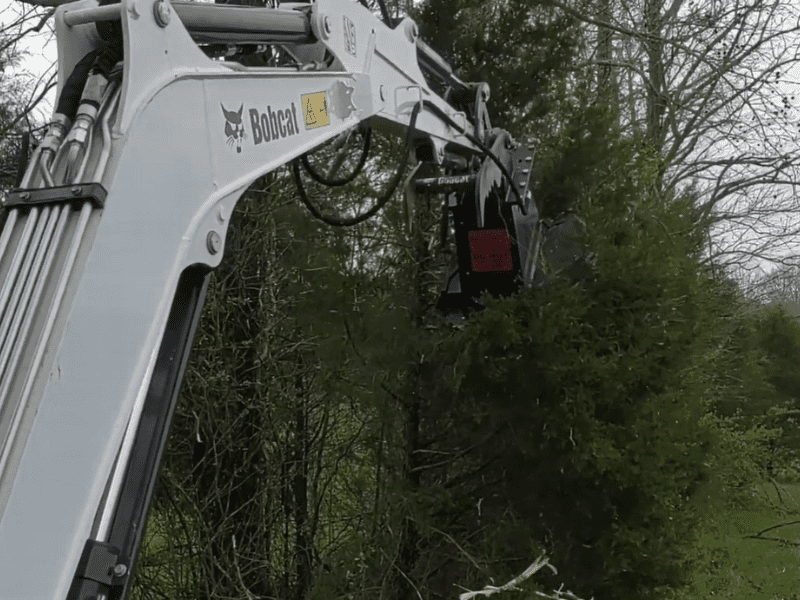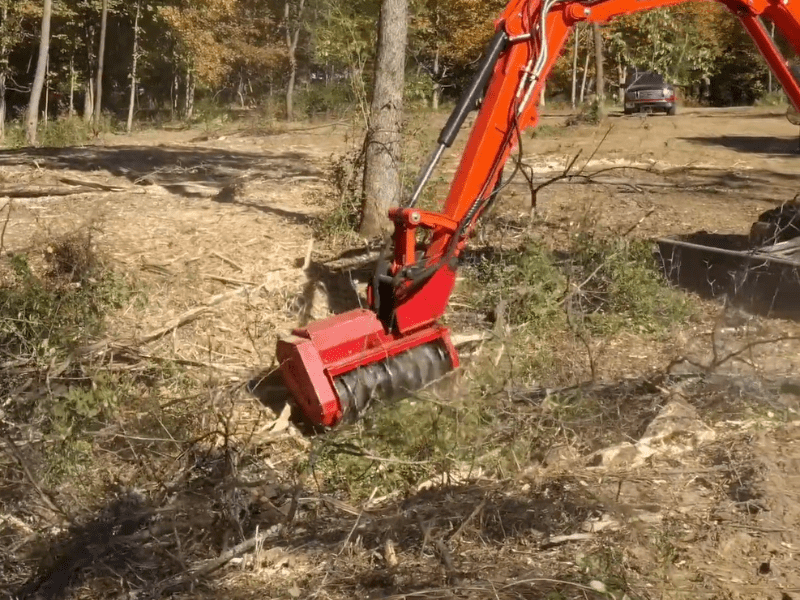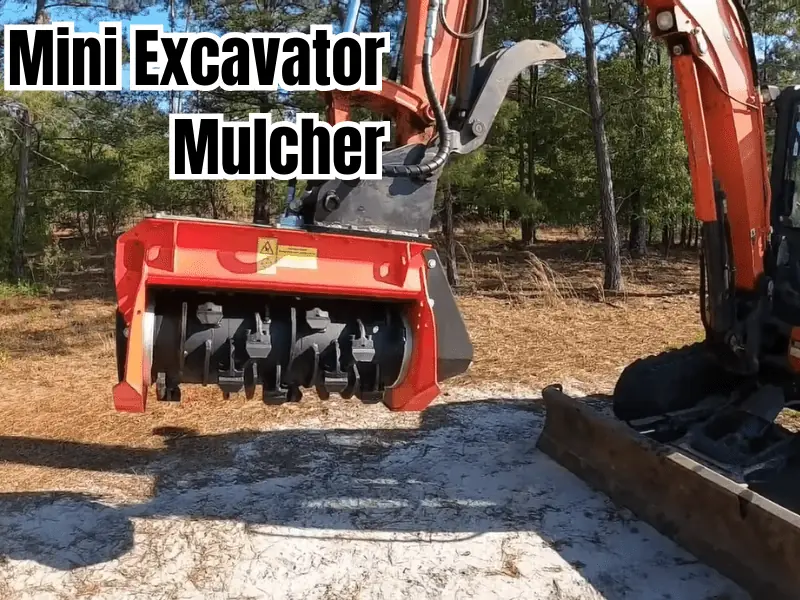A mini excavator mulcher is a specialized attachment that can add to a mini excavator or construction equipment used for digging and excavation. It is used to grind and shred trees, bushes, and other vegetation, allowing easy removal and disposal.
The mini excavator mulchers consist of a rotary cutting head with sharp blades that spin at high speeds, powered by the excavator’s hydraulic system. The excavator operator can use the Mulcher to clear and thin out overgrown areas, remove unwanted vegetation, and prepare land for landscaping or other construction projects.
Mini excavator mulchers are commonly used in forestry, land clearing, and road maintenance applications. They can be a cost-effective and efficient alternative to larger, more expensive equipment and easily access tight or hard-to-reach areas.
How mini excavator Mulcher works
The mulcher attachment is connected to the excavator’s hydraulic system, which provides the power to operate the mulching head. When the mini excavator mulcher is in operation, the operator positions the excavator near the vegetation that needs to be cleared.
The mulching head of the attachment is then lowered onto the vegetation, and the excavator’s hydraulic system powers the Mulcher’s blades to spin rapidly. They cut through the vegetation as the blades rotate, grinding it into small pieces. The mulcher head is designed for grinding and shredding trees, bushes, and other vegetation in minutes.
The shredded vegetation is then discharged from the back of the Mulcher and onto the ground, where it can be further processed or removed. Mini excavator mulchers are designed to work on various terrains, including steep slopes and uneven terrain. They can also clear and thin out overgrown areas, making them an ideal tool for forestry, land clearing, and road maintenance applications.
Benefits of mini excavator Mulchers
There are several benefits of using a mini excavator mulcher for vegetation removal and land-clearing projects:

Efficient and Effective: Mini excavator mulchers are a very efficient and effective tool for grinding and shredding vegetation. They can quickly process large amounts of material, saving time and labor costs.
Versatile: Mini excavator mulchers are versatile and can be used in various applications, including forestry, land clearing, and road maintenance projects.
Cost-effective: Mini excavator mulchers are a cost-effective alternative to using larger equipment. They need less fuel and maintenance and can access tight or hard-to-reach areas that larger equipment cannot.
Precise: Mini excavator mulchers can be precisely operated, allowing for more accurate and targeted vegetation removal.
Environmentally friendly: Mini excavator mulchers are a more environmentally friendly option for land clearing projects as they do not require harsh chemicals or pesticides.
Improves Land Health: By removing unwanted vegetation, mini excavator mulchers can help improve the health and appearance of the land.
Increased Safety: Mini excavator mulchers provide a safer alternative to using chainsaws or other dangerous equipment for vegetation removal.
Different types of mini excavator Mulchers
Different mini excavator mulchers are designed to meet specific vegetation removal and land clearing needs.
Disc Mulcher:
A disc mulcher is a mini excavator mulcher with a circular disc with teeth around the edge. The teeth cut through vegetation as the disc spins, shredding it into small pieces. Disc mulchers are ideal for grinding and shredding small trees, brush, and other vegetation.
Flail Mulcher:
A flail mulcher has a series of small, swinging blades that rotate at high speeds, cutting through vegetation. The blades are attached to a drum powered by the excavator’s hydraulic system. Flail mulchers are designed to cut through thicker vegetation, such as branches and larger trees.
Drum Mulcher:
A drum mulcher has a cylindrical drum with teeth or blades that grind and shred vegetation as it is fed into the machine. Drum mulchers are ideal for grinding and shredding small trees, brush, and other vegetation. They are also more versatile and can be used in various applications, including forestry, land clearing, and road maintenance projects.
Forestry Mulcher:
A forestry mulcher is a heavy-duty mulcher designed for forestry applications. It has a large cutting head with teeth that can cut through thick brush and trees. Forestry mulchers are often used to remove invasive species or for land restoration projects.
Stump Grinder:
A stump grinder is a mini excavator mulcher designed to remove tree stumps. It has a grinding wheel with sharp teeth can quickly and efficiently grind down stumps to below ground level. Stump grinders are often used in landscaping or construction projects where trees have been removed, and the stumps need to be cleared.
The type of mulcher best suited for a particular job will depend on the vegetation removed, the terrain, and the project’s scope.
How to attach a mini excavator Mulcher
Attaching a mini excavator mulcher to a mini excavator is fairly straightforward.
- Before attaching the mini excavator mulcher, make sure the mini excavator is properly prepared. It includes ensuring it is on level ground, the hydraulic system is engaged, and the bucket or other attachment is removed.
- Position the Mulcher Attachment: The next step is to position the mulcher attachment close to the mini excavator. Use the excavator’s boom and arm to move the Mulcher into position.
- The mulcher attachment should have a mounting plate that aligns with the mounting plate on the mini excavator. Make sure the mounting plates are lined up properly.
- The mulcher attachment will have hydraulic hoses that must be connected to the mini excavator’s hydraulic system. Attach the hoses to the appropriate hydraulic ports on the excavator.
- Once the hydraulic hoses are connected, secure the attachment to the mini excavator. It involves tightening bolts or other mechanisms to securely fasten the attachment to the excavator.
- Before using the mini excavator mulcher, test the attachment to ensure it works properly. Engage the hydraulic system and check that the blades on the mulcher attachment are spinning correctly.
- Following the manufacturer’s instructions for attaching the Mulcher to the mini excavator is important to ensure it is done correctly and safely. If you are unsure how to attach the attachment, refer to the owner’s manual or consult a professional operator.
What to look for mini excavator Mulcher
Several factors must be considered when looking for a mini excavator mulcher to ensure you choose the right tool for your project. Here are some things to look for:

Mulching Capacity:
The primary factor to consider is the mulching capacity of the mini excavator mulcher. It refers to how much vegetation the machine can mulch in a given time. Look for a machine with a high mulching capacity if you have a large project requiring quickly clearing a lot of vegetation.
Mulching Width:
The width of the mulching head is another important factor to consider. A wider mulching head can cover more ground and clear more vegetation quickly. However, a narrower head may be more suitable for tight or hard-to-reach areas.
Cutting Depth:
The cutting depth of the mulcher head refers to the maximum thickness of vegetation the machine can cut. Consider the type and thickness of vegetation you need to remove and choose a machine with a cutting depth that meets your needs.
Power and Speed:
Look for a mini excavator mulcher with a powerful engine and high-speed rotation for efficient and effective grinding and shredding of vegetation.
Hydraulic Flow:
The hydraulic flow of the mini excavator mulcher should match that of the mini excavator. Check both machines’ specifications and ensure the hydraulic flow rate is compatible.
Weight and Size:
Consider the weight and size of the mini excavator mulcher and ensure that it is suitable for the mini excavator. A machine that is too heavy or large may be difficult to manoeuvre and operate.
Durability and Maintenance:
Look for a mini excavator mulcher that is built with high-quality materials and is designed for easy maintenance. A durable machine will last longer and require less maintenance, saving you money and hassle.
Price:
Finally, consider the price of the mini excavator mulcher and ensure that it fits within your budget. Look for a machine that provides good value for money and meets your project needs.
Use of mini excavator Mulcher
A mini excavator mulcher is a versatile machine that can be used for a variety of applications, including:
Land Clearing:
Mini excavator mulchers are commonly used for land clearing projects, such as removing overgrown brush, trees, and other vegetation. The machine can quickly and efficiently grind and shred the vegetation, making removing and preparing the land for construction, landscaping, or other uses easier.
Forestry Work:
Mini excavator mulchers can also be used for forestry work, such as thinning trees and removing underbrush. The machine can shred and mulch the vegetation, leaving the forest floor clean and ready for replanting or other uses.
Roadside Maintenance:
Mini excavator mulchers are often used for roadside maintenance projects, such as clearing overgrown vegetation along highways and other roads. The machine can safely and efficiently remove vegetation, reducing the risk of accidents and improving visibility for drivers.
Property Maintenance:
Mini excavator mulchers can be used for property maintenance projects, such as clearing overgrown vegetation from yards, parks, and other outdoor spaces. The machine can quickly and efficiently clear the area, leaving it neat.
Erosion Control:
Mini excavator mulchers can also be used for erosion control projects, such as clearing vegetation from stream banks and other areas prone to erosion. The machine can shred the vegetation and leave the soil in place, reducing the risk of erosion and improving water quality.
Conclusion
Mini excavator mulchers are powerful and versatile machines that you can use for many tasks easier and more efficiently. When choosing a mini excavator mulcher, it is important to consider factors such as the mulching capacity, width, cutting depth, power, hydraulic flow, weight, price, and the project’s specific needs. If you need more information, you can contact us.

